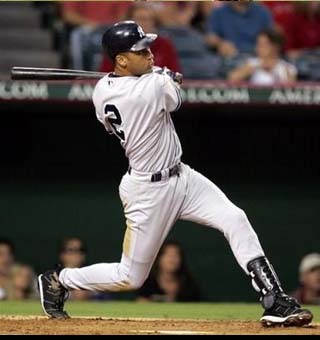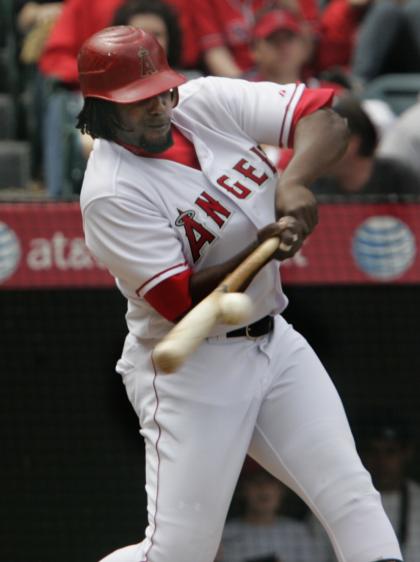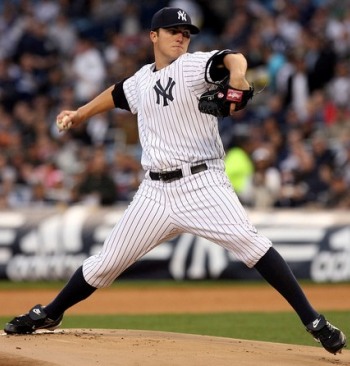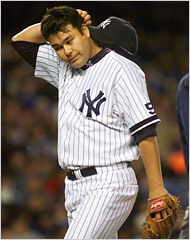The Yankees easily dispatched the Minnesota Twins last week, but they've got their work cut out for them in facing the LAnahfornia Angels of WhereEver in the American league Championship Series.
Compare/Contrast with the Minnesota Twins:
The Angels finished a close second to the Yankees in run scoring this year, with 5.45 runs per game, compared to 5.65 for the Yankees. Minnesota had scored 5.01 runs per game, but they did so in a pitchers' park, while both LAnahfornia and New York played their home games in hitters' parks, so Minnesota actually had a slightly better adjusted OPS than the Angels, 109 compared to 104. The Yankees' 119 OPS+ easily led all of MLB.
Of course, the fact that Justin Morneau was unavailable for the postseason after having provided 30 homers and 100 RBIs toward the Twins' offense during the season probably puts the Angels roughly on par with the Twins for our purposes. The Angels stole a lot more bases, but otherwise, the net result was about the same.
In terms of pitching, it would seem that the Twins and Angels were very similar as well, given that both teams allowed about 4.7 runs per game (4.69 for the Twins), and had ERAs that were very close (4.50 for the Angels, 4.45 for Minnesota). Again, however, the ballparks skew these numbers, so that the Twins's adjusted ERA+ was only 92, well below the league average, while the Angels were a tick above average, at 102.
Starting Pitching:
Angels
The Angels and Yankees' starters overall had composite ERAs very close to each other, 4.44 for the Angels, 4.48 for New York, but those overall numbers ignore the fact that this Angels' pitching staff is not the same one that started the year. Gone are Sean O'Sullivan, Shane Loux, Trevor Bell, Anthony Ortega and Dustin Moseley, who combined for a 6.51 ERA in 26 starts this year. Sixteen of those 26 starts went to two pitchers (Bell and O'Sullivan) who had never pitched above High-A ball before the start of the 2009 season, and it showed.
And though he isn't "gone", Ervin Santana and his 5.03 ERA are banished to the bullpen and replaced in the rotation by lefty import Scott Kazmir, who has generally pitched well against the Yankees (2.67 ERA in 87 career innings). Kazmir compiled a 1.73 ERA in six late season starts for the Angels, though he got knocked around by the Red Sox in his lone postseason start this year, and is not known for his stamina.
Yankees
Everyone knows that the Yankees plan to use a three-man rotation for the ALCS, with CC Sabathia, AJ Burnett and Andy Pettitte the three named men. Joba Chamberlain is relegated to bullpen duty, where he has excelled throughout his major league career, though he's done little of that kind of work in 2009. If all goes to plan, the only one who will need to pitch on short rest is CC Sabathia, and if he falters, Joba should be able to step up and blow it by the Angels' hitters for a couple of innings to bridge the gap to the usual bullpen suspects.
The Yankees struggled to find an effective 5th starter all year, which skews the team's starter ERA way up, mostly due to Chien-Ming Wang and Sergio Mitre, who won't pitch against LAnahfornia.
The composite stats for the starters who are expected to pitch in this series are as follows:
Team W L ERA ERA+ G IP WHIP H/9 HR/9 BB/9 SO/9
Angels 53 32 4.22 109 117 721.2 1.33 9.04 1.10 2.96 6.63
Yanks 46 25 3.83 117 99 631.2 1.30 8.30 0.90 3.42 7.70
The Yankees' numbers here are for just three starters, but they do have a notable edge in most areas, except walks per nine. (If you use only Scott Kazmir's work as an Angel the teams are almost dead even, but then why would we want to throw out his deeds in the first two-thirds of the season simply because he didn't have a big "A" on his hat when he compiled them?)
Overall you'd have to say the Yankees have an edge here, if only a slight one, which may be negated by the fact that CC will have to pitch on short rest.
Bullpens:
If the Yankees can get to Kazmir (or any of the Angels' starters) early, their hitters should be able to feast on their relatively soft bullpen, which was 23rd among the 30 MLB teams in ERA, while the Yankees bullpen compiled a 3.91 ERA that was good for 13th in MLB. These, again, are numbers skewed by pitchers who are not on the ALCS rosters. The relevant pitchers' composite numbers are:
Team W L ERA SV IP ERA+ WHIP H/9 HR/9 BB/9 SO/9
Angels 37 21 4.12 50 509.1 116 1.34 8.61 0.99 3.48 7.12
Yanks 39 20 3.81 51 552.2 117 1.25 7.95 1.14 3.27 8.62
Here the Yankees have advantages in almost every category> The difference in homers allowed is probably mostly due to the New Yankee Stadium's bizarre performance early in the year, but in all honesty, I did not check on that.
These numbers include Joba's stats for the Yankees and those of Ervin Santana for the Angels, each of whom should be considerably better when restricted to relief duties. It's worth noting that Santana has made only three relief appearances in his four-year major league career, plus two in the postseason, with mixed results, but there's no reason to think he can't adjust to the role.

Overall I'd have to give the edge to the Yankees' bullpen, who are more likely to get a key strikeout in a big spot and do a slightly better job of keeping guys off base.
Offense:
I don't have to tell you that the Yankees led the major leagues in run scoring this season, not to mention homers, OBP, Slugging, OPS and OPS+. The Angels were not far behind the Yankees in runs scored, but they accomplished this, as they seemingly always do, more with timely hitting than with sheer brute strength, like the Yankees.
The Yankees got men on base better than any team in baseball and just took their chances at getting timely hitting. The Angels did a decent job of getting men on base (they were 3rd in MLB in on base percentage, thanks mostly to Bobby Abreu and Chone Figgins, who nearly doubled his walk rate this year). But then the Angels hit .297 with runners in scoring position, compared to just .272 for the Yankees. Whether that pace is maintainable is anybody's guess, but in any case, the Angels know how to score runs.

Neither team really has any holes in its lineup, either. The Yankees famously got 20+ homers from seven different players, with another 18 from Derek Jeter and more than a dozen from melky Cabrera. Every starter on both teams hit at least .270 except Nick Swisher, who was 2nd in the AL with 97 walks, providing for a respectable .371 OBP. The Yankees have both speed and power on the bench, too, as Brett Gardner and his 26 steals and Eric Hinske's .512 slugging percentage will attest.
Everyone in the Angels' lineup hit between .287 and .306 except Mike Napoli, who hit .272 and smacked 20 homers in only 114 games. Despite all the talk you've heard about how Abreu made the team more patient this year, nobody besides him and Chone Figgins really likes to walk much. They've got some power, but Vlad Guerrero isn't the threat he once was and Kendry Morales is the only player in their lineup with more than 25 homers. As a team, they were just 8th in homers, though they were 4th in slugging percentage. The Angels can bring in Macier Isturis off their bench, who hit .300 and stole a baker's dozen worth of bases, but the bench gets pretty thin after that.
Again, the advantage seems to be with New York, but a few timely hits by the Angels could negate a lot of patience and brute strength on the part of the bronx Bombers.
Head-to-Head:
The Yankees split the 10 games they played against the Angels this year, but their 5-5 record belies how badly the Yankees played in many of those games.
R 2B 3B HR SB CS BA OBP SLG OPS BAbip
ANA 65 18 5 9 17 7 .315 .386 .473 859 .363
NYY 55 15 1 15 9 0 .272 .355 .456 811 .291
Other than hitting more homers than the Angels, the Yankees were out-hit in just about every respect. Both teams walked and struck out at about the same rates, but the Angels hit more singles, doubles and triples, hit for a higher average, and stole a lot more bases. Of course, getting caught seven times in 24 tries essentially negated the value of the 17 bases they stole, at least on paper.

In reality, it wasn't quite so cut and dried. The conventional wisdom is that the Angels' speed and Jorge Posada's sub-par arm will allow LAnahfornia to run all over the Yankees, but I'm not so sure about this. Looking back at the season series, I see little indication that the Angels are truly great base stealers. In fact, when you look at all 25 times they tried a steal, they actually succeeded in scoring a meaningful run just one time.
One.
Let me explain:
Among those seven times caught stealing (plus one pick-off of Torii Hunter, courtesy of Andy Pettitte's infamous move to first) five of them resulted in the third out of an inning. Three of those eight times (including the pick-off) came in games that were decided by one run. The Angels may have run themselves right out of three wins.
Even among the 17 successful steals, only five of them clearly helped the Angels. The rest of the steals either resulted in a runner being stranded on 2nd or third, or the runner scoring on a homer, which would have occurred regardless of the base the runner had been on at the time. And of the five that "helped", only one occurred in a game decided by fewer than three runs.
You see, the running game is not nearly so important as some would have you think. For one thing, steals are not always successful. When a base stealer fails, or even if a runner gets picked off, you lose both a baserunner and an out, which compromises anything that might have been done that inning. Even when a rally isn't killed by getting caught stealing, it can certainly be suppressed somewhat. And even when a steal is both successful and results in a run, it is not always a run that's needed to win.
So even if the Angels do manage to wreak havoc on the basepaths - and with all the rain in New York this weekend, it's hard to imagine that - it won't necessarily lead to victory. So what else have they got going for them?

Well, overall, in the ten games they played against New York, they hit quite a bit better, as I mentioned. The most glaring difference is that the Angels hit .363 - more than 70 points higher than the Yankees - when they put the ball in play, easily the highest BABIP mark by any Yankee opponent this year, and considerably better than the Angels' season mark of .322. Given that the league averaged .300 this year, it's possible that we could see some regression to the mean, but a short playoff series doesn't always allow for the time needed for such regressions.
The Yankees allowed a 6.28 ERA to the Angels in their ten games this year, and though an optimist might point out that a lot of the runs they allowed were given up by the likes of Mark Melancon, Brian Bruney and Jose Veras, players who are not on the Yankees' ALCS roster. The pitchers who might pitch in the Series, however, combined to allow the Angels a still unimpressive 5.89 ERA. Not a good sign.
Meanwhile, the Angels' pitchers allowed a 5.28 ERA against the 2009 Yankees in the regular season, but when you eliminate the runs allowed by Anthony Ortega, Justin Speier and others who aren't on the postseason roster, that number comes down to a more respectable 4.52, which is pretty darn good when you consider that the Yankees averaged 5.65 runs per game overall.
In short, looking at the teams' overall numbers seems to show an advantage for the Yankees at almost every turn. Looking at just their head-to-head stats, the Angels appear to be better, but those were only 10 games out of 162, so I'm not willing to lend them so much credence.
My best guess is that the Yankees win it in 6, with at least four of the games being decided by two runs or fewer. It's going to be a great series.





































